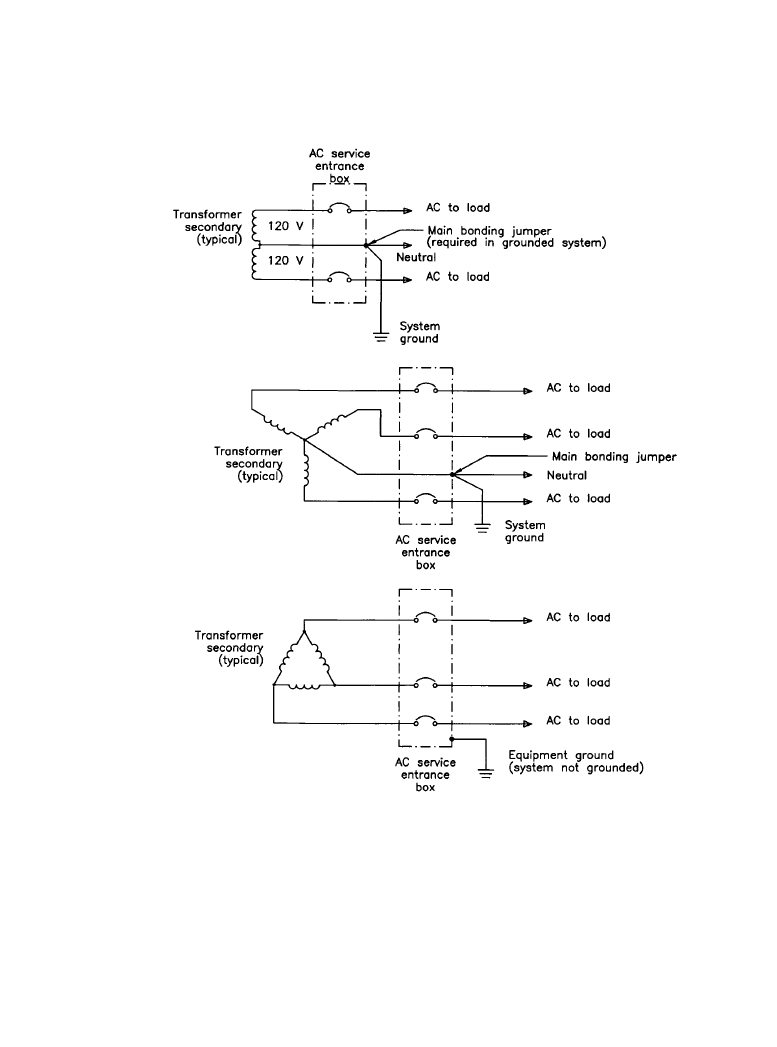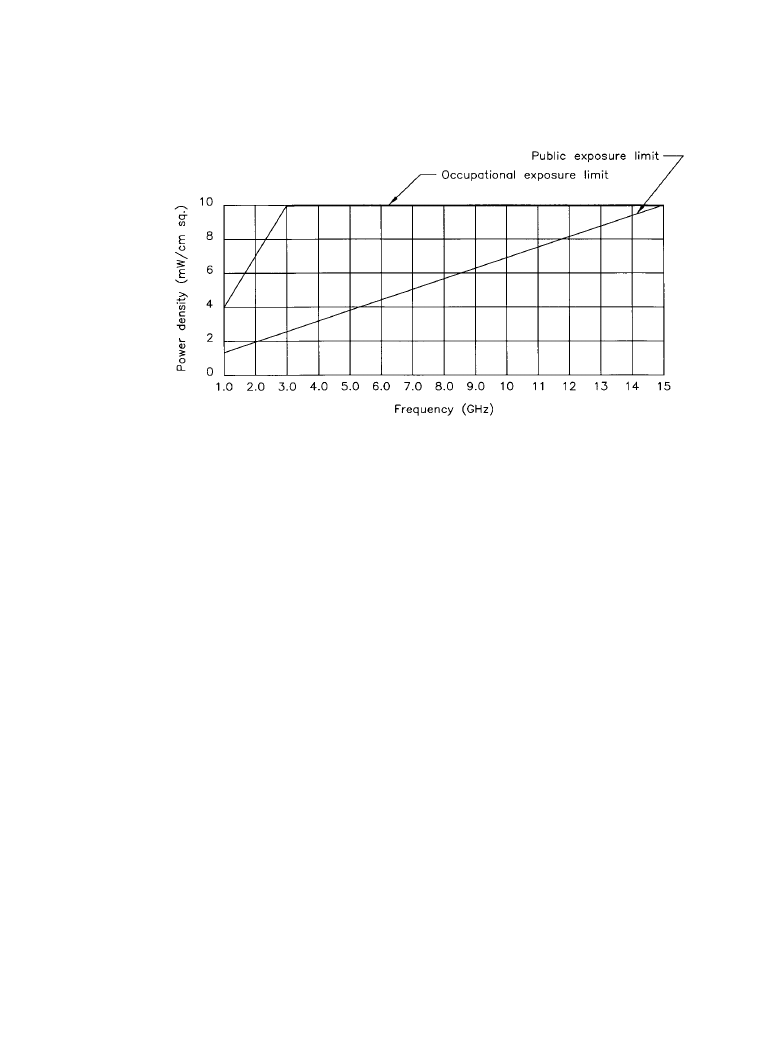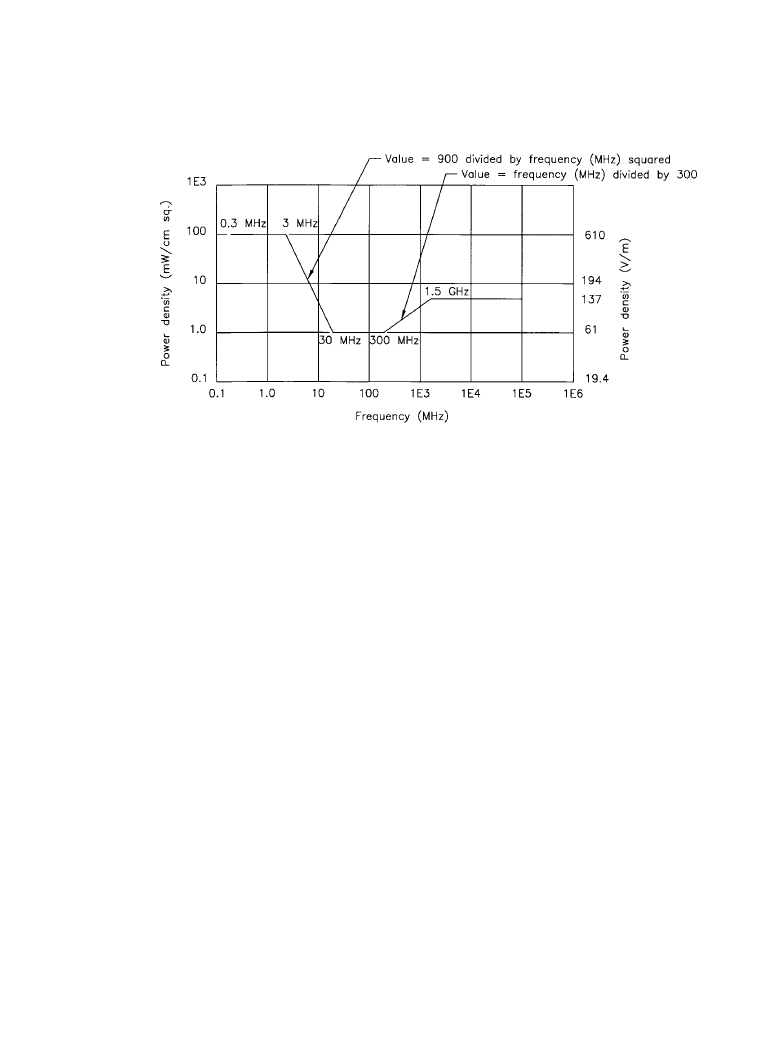ВУЗ: Казахская Национальная Академия Искусств им. Т. Жургенова
Категория: Книга
Дисциплина: Не указана
Добавлен: 03.02.2019
Просмотров: 21576
Скачиваний: 19

Safety Issues 13-47
(
a)
(
b)
(
c)
Figure 13.3.6
AC service entrance bonding requirements: (
a) 120 V phase-to-neutral (240 V
phase-to-phase), (
b) 3-phase 208 V wye (120 V phase-to-neutral), (c) 3-phase 240 V (or 480 V)
delta. Note that the main bonding jumper is required in only two of the designs.
Downloaded from Digital Engineering Library @ McGraw-Hill (www.digitalengineeringlibrary.com)
Copyright © 2004 The McGraw-Hill Companies. All rights reserved.
Any use is subject to the Terms of Use as given at the website.
Safety Issues

13-48 Standards and Practices
ceramics that produce dust or fumes, such as grinding, grit blasting, or acid cleaning. Beryllium
oxide dust and fumes are highly toxic, and breathing them can result in serious personal injury or
death.
If a broken window is suspected on a microwave tube, carefully remove the device from its
waveguide, and seal the output flange of the tube with tape. Because BeO warning labels may be
obliterated or missing, maintenance personnel should contact the tube manufacturer before per-
forming any work on the device. Some tubes have BeO internal to the vacuum envelope.
Take precautions to protect personnel working in the disposal or salvage of tubes containing
BeO. All such personnel should be made aware of the deadly hazards involved and the necessity
for great care and attention to safety precautions. Some tube manufacturers will dispose of tubes
without charge, provided they are returned to the manufacturer prepaid, with a written request for
disposal.
13.3.4a
Corrosive and Poisonous Compounds
The external output waveguides and cathode high-voltage bushings of microwave tubes are
sometimes operated in systems that use a dielectric gas to impede microwave or high-voltage
breakdown. If breakdown does occur, the gas may decompose and combine with impurities, such
as air or water vapor, to form highly toxic and corrosive compounds. Examples include Freon
gas, which may form lethal phosgene, and sulfur hexafluoride (SF
6
) gas, which may form highly
toxic and corrosive sulfur or fluorine compounds such as beryllium fluoride. When breakdown
does occur in the presence of these gases, proceed as follows:
•
Ventilate the area to outside air
•
Avoid breathing any fumes or touching any liquids that develop
•
Take precautions appropriate for beryllium compounds and for other highly toxic and corro-
sive substances
•
If a coolant other than pure water is used, follow the precautions supplied by the coolant man-
ufacturer.
FC-75 Toxic Vapor
The decomposition products of FC-75 are highly toxic. Decomposition may occur as a result of
any of the following:
•
Exposure to temperatures above 200°C
•
Exposure to liquid fluorine or alkali metals (lithium, potassium, or sodium)
•
Exposure to ionizing radiation
Known thermal decomposition products include perfluoroisobutylene (PFIB; [CF
3
]
2
C = CF
2
),
which is highly toxic in small concentrations.
If FC-75 has been exposed to temperatures above 200°C through fire, electric heating, or pro-
longed electric arcs, or has been exposed to alkali metals or strong ionizing radiation, take the
following steps:
•
Strictly avoid breathing any fumes or vapors.
Downloaded from Digital Engineering Library @ McGraw-Hill (www.digitalengineeringlibrary.com)
Copyright © 2004 The McGraw-Hill Companies. All rights reserved.
Any use is subject to the Terms of Use as given at the website.
Safety Issues

Safety Issues 13-49
•
Thoroughly ventilate the area.
•
Strictly avoid any contact with the FC-75.
•
Under such conditions, promptly replace the FC-75 and handle and dispose of the contami-
nated FC-75 as a toxic waste.
13.3.5 Nonionizing Radiation
Nonionizing radio frequency radiation (RFR) resulting from high-intensity RF fields is a grow-
ing concern to engineers who must work around high-power transmission equipment. The princi-
pal medical concern regarding nonionizing radiation involves heating of various body tissues,
which can have serious effects, particularly if there is no mechanism for heat removal. Recent
research has also noted, in some cases, subtle psychological and physiological changes at radia-
tion levels below the threshold for heat-induced biological effects. However, the consensus is that
most effects are thermal in nature.
High levels of RFR can affect one or more body systems or organs. Areas identified as poten-
tially sensitive include the ocular (eye) system, reproductive system, and the immune system.
Nonionizing radiation also is thought to be responsible for metabolic effects on the central ner-
vous system and cardiac system.
In spite of these studies, many of which are ongoing, there is still no clear evidence in West-
ern literature that exposure to medium-level nonionizing radiation results in detrimental effects.
Russian findings, on the other hand, suggest that occupational exposure to RFR at power densi-
ties above 1.0 mW/cm
2
does result in symptoms, particularly in the central nervous system.
Clearly, the jury is still out as to the ultimate biological effects of RFR. Until the situation is
better defined, however, the assumption must be made that potentially serious effects can result
from excessive exposure. Compliance with existing standards should be the minimum goal, to
protect members of the public as well as facility employees.
13.3.5a
NEPA Mandate
The National Environmental Policy Act of 1969 required the Federal Communications Commis-
sion to place controls on nonionizing radiation. The purpose was to prevent possible harm to the
public at large and to those who must work near sources of the radiation. Action was delayed
because no hard and fast evidence existed that low- and medium-level RF energy is harmful to
human life. Also, there was no evidence showing that radio waves from radio and TV stations did
not constitute a health hazard.
During the delay, many studies were carried out in an attempt to identify those levels of radia-
tion that might be harmful. From the research, suggested limits were developed by the American
National Standards Institute (ANSI) and stated in the document known as ANSI C95.1-1982.
The protection criteria outlined in the standard are shown in Figure 13.3.7.
The energy-level criteria were developed by representatives from a number of industries and
educational institutions after performing research on the possible effects of nonionizing radia-
tion. The projects focused on absorption of RF energy by the human body, based upon simulated
human body models. In preparing the document, ANSI attempted to determine those levels of
Downloaded from Digital Engineering Library @ McGraw-Hill (www.digitalengineeringlibrary.com)
Copyright © 2004 The McGraw-Hill Companies. All rights reserved.
Any use is subject to the Terms of Use as given at the website.
Safety Issues

13-50 Standards and Practices
incident radiation that would cause the body to absorb less than 0.4 W/kg of mass (averaged over
the whole body) or peak absorption values of 8 W/kg over any 1 gram of body tissue.
From the data, the researchers found that energy would be absorbed more readily at some fre-
quencies than at others. The absorption rates were found to be functions of the size of a specific
individual and the frequency of the signal being evaluated. It was the result of these absorption
rates that culminated in the shape of the safe curve shown in the figure. ANSI concluded that no
harm would come to individuals exposed to radio energy fields, as long as specific values were
not exceeded when averaged over a period of 0.1 hour. It was also concluded that higher values
for a brief period would not pose difficulties if the levels shown in the standard document were
not exceeded when averaged over the 0.1-hour time period.
The FCC adopted ANSI C95.1-1982 as a standard that would ensure adequate protection to
the public and to industry personnel who are involved in working around RF equipment and
antenna structures.
Revised Guidelines
The ANSI C95.1-1982 standard was intended to be reviewed at 5-year intervals. Accordingly, the
1982 standard was due for reaffirmation or revision in 1987. The process was indeed begun by
ANSI, but was handed off to the Institute of Electrical and Electronics Engineers (IEEE) for
completion. In 1991, the revised document was completed and submitted to ANSI for acceptance
as ANSI/IEEE C95.1-1992.
The IEEE standard incorporated changes from the 1982 ANSI document in four major areas:
•
An additional safety factor was provided in certain situations. The most significant change
was the introduction of new uncontrolled (public) exposure guidelines, generally established
Figure 13.3.7
The power density limits for nonionizing radiation exposure for humans
Downloaded from Digital Engineering Library @ McGraw-Hill (www.digitalengineeringlibrary.com)
Copyright © 2004 The McGraw-Hill Companies. All rights reserved.
Any use is subject to the Terms of Use as given at the website.
Safety Issues

Safety Issues 13-51
at one-fifth of the controlled (occupational) exposure guidelines. Figure 13.3.8 illustrates the
concept for the microwave frequency band.
•
For the first time, guidelines were included for body currents; examination of the electric and
magnetic fields were determined to be insufficient to determine compliance.
•
Minor adjustments were made to occupational guidelines, including relaxation of the guide-
lines at certain frequencies and the introduction of breakpoints at new frequencies.
•
Measurement procedures were changed in several aspects, most notably with respect to spa-
tial averaging and to minimum separation from reradiating objects and structures at the site.
The revised guidelines are complex and beyond the scope of this handbook. Refer to the
ANSI/IEEE document for details.
13.3.5b
Multiple-user Sites
At a multiple-user site, the responsibility for assessing the RFR situation—although officially
triggered by either a new user or the license renewal of all site tenants—is, in reality, the joint
responsibility of all the site tenants. In a multiple-user environment involving various frequen-
cies, and various protection criteria, compliance is indicated when the fraction of the RFR limit
within each pertinent frequency band is established and added to the sum of all the other frac-
tional contributions. The sum must not be greater than 1.0. Evaluating the multiple-user environ-
ment is not a simple matter, and corrective actions, if indicated, may be quite complex.
Figure 13.3.8
ANSI/IEEE exposure guidelines for microwave frequencies.
Downloaded from Digital Engineering Library @ McGraw-Hill (www.digitalengineeringlibrary.com)
Copyright © 2004 The McGraw-Hill Companies. All rights reserved.
Any use is subject to the Terms of Use as given at the website.
Safety Issues